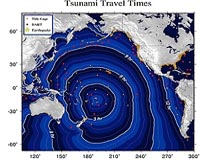| . |  |
. |
Apia (AFP) Oct 4, 2009 When Sister Doris Barbero heard the church bells ringing after a frightening earthquake near her seaside school in Samoa, she knew to gather her young students and run for higher ground. "We have done this drill before. We knew what we had to do, we had to leave the premises and go up to the hills," the nun told AFP from her school in Leava'a in the devastated southwest of the Pacific nation. Samoans had only minutes to react after a 8.0-magnitude undersea quake rocked the nation early Tuesday before the terrifying tsunami waves swept away coastal villages and holiday resorts, killing at least 176 people in the region. But despite improved education programs about the dangers of giant waves since the catastrophic Asian tsunami of 2004, experts said many people still failed to heed the lessons of the Indian Ocean disaster. "There's no apparent reduction in the number of people killed in earthquakes and tsunamis with time and it's just getting worse because there are more people and people want to live by the sea," said Kevin McCue, president of the Australian Earthquake Engineering Society. "I don't think we've learnt anything to be quite honest." McCue said it was only human nature that people who lived close to the sea, particularly in idyllic holiday spots, refused to believe that the water could one day sweep them away. "People don't think it's going to happen to them," he told AFP. "It's human nature. They don't want to remember the bad things and they want to think they are one-offs and won't happen again." Professor Bill McGuire, of the Aon Benfield UCL Hazard Research Centre in Britain, said the Samoan disaster showed there needed to be more education about the nature and power of tsunamis almost five years on from the 2004 event which killed some 220,000 people around the Indian Ocean. "Most critically, populations living close to faults capable of producing earthquakes that trigger tsunamis must be taught to self-evacuate when the ground shakes or the sea recedes," he said. "Waiting for a warning from a central monitoring station could mean the difference between life and death." Associate Professor Dale Dominey-Howes, co-director of the Australian Tsunami Research Centre and Natural Hazards Research Laboratory at Sydney's University of New South Wales, said some people clearly knew to evacuate. "Unconfirmed reports suggest that in some places people recognised the natural warning signs for the tsunami and evacuated to higher ground," he said. But he added: "In other areas this does not seem to have happened." Ray Canterford, from Australia's Tsunami Warning Centre at the Bureau of Meteorology, said Pacific nations had improved education about the dangers of tsunamis since 2004 while alert systems had also been upgraded. Many Pacific islands also now regularly practised evacuation drills while improved instrumentation allowed scientists to predict accurately the site and magnitude of quakes and the time any tsunamis might hit land, he told AFP. "I think there's probably a fallacy somewhere where people say, 'Oh, they couldn't have done very much' and I don't think that's true. I think a lot was done at the time," Canterford said. "This is going to be a very educational, informative experience to assess... countries, how they react and where they got their information."
Share This Article With Planet Earth
Related Links Bringing Order To A World Of Disasters When the Earth Quakes A world of storm and tempest
 Death toll nears 150 as Samoa tsunami devastation revealed
Death toll nears 150 as Samoa tsunami devastation revealedApia (AFP) Oct 1, 2009 Rescuers reached scenes of stunning devastation on Wednesday after a killer tsunami obliterated Samoan island villages, killing at least 148 people and leaving scores more missing. As distraught relatives picked through the rubble of homes and tourist resorts destroyed by Tuesday's 8.0-magnitude earthquake that triggered a tsunami, aid workers were left breathless at the catastrophe. ... read more |
|
| The content herein, unless otherwise known to be public domain, are Copyright 1995-2009 - SpaceDaily. AFP and UPI Wire Stories are copyright Agence France-Presse and United Press International. ESA Portal Reports are copyright European Space Agency. All NASA sourced material is public domain. Additional copyrights may apply in whole or part to other bona fide parties. Advertising does not imply endorsement,agreement or approval of any opinions, statements or information provided by SpaceDaily on any Web page published or hosted by SpaceDaily. Privacy Statement |